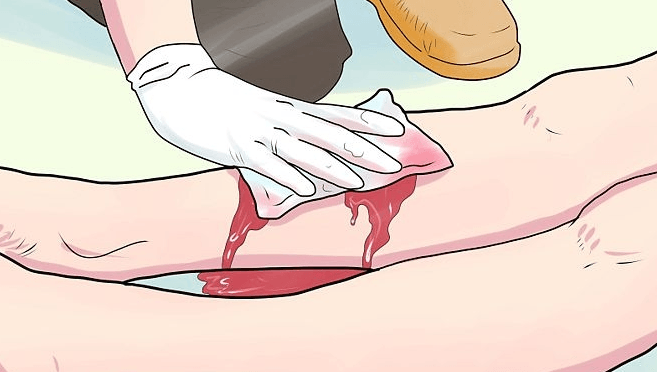A recent report from England of an elderly woman who died from a bleeding varicose vein in her leg has prompted a few calls to both my Long Island and New York City offices. While there are always occasional reports of deaths from ruptured veins, (one surgical journal suggested as many as 23 deaths in the U.K. in one year, although that number seems exceedingly high to us) the good news is that is still a very rare phenomenon.
This post is designed to both help out in the event of a hemorrhage and address common underlying reasons that bleeding from varicose vein or spider veins may occur.
When a Vein Bleeds, What Should You Do ?
• First thing to do is to remain calm. Spontaneous outflows are often from very small openings and are more likely to ooze then spurt blood. The pulsatile squirting of blood is seen with arteries and not with veins.
• Apply direct pressure over the open wound. It’s extremely unlikely that more than one break of the skin has occurred so start by applying either a finger or a cloth over the opening and applying direct and firm pressure.
• Elevate the leg. Lifting the leg above the heart is ideal but even lifting it above the waistline will alleviate much of the pressure in the veins and dramatically slow or even stop the seeping of blood. We often tell patients to hold pressure for longer than they might think is necessary to fully ensure a scab and clot have formed.
• DO NOT use a tourniquet !! Tourniquets are used to ‘trap or hold’ blood in the veins. (For example, when drawing blood for testing.) If applied incorrectly, the compressive wrap can actually do more harm than good.
• Seek medical attention. Once the bleeding has stopped there is a significant chance of recurrence. By seeing a doctor for treatment of the veins you can dramatically reduce the chances of it happening again.
• As one would expect, the incidence of bleeding from veins far exceeds the incidences in fatalities resulting from ruptured veins. In two surgical journal articles, the reported rate at which patients were seen at local ER’s in Chicago was only 14 patients in 4 years, while in a large European hospital it was 124 bleeds over 5 years.
Factors Predisposing To Bleeds From Leg Vein
• Minor trauma- While sometimes a rupture seemingly occurs without any underlying physical contact obviously a bang or bump on the legs can break the skin. A very common place to experience a hemorrhage is in the shower. While it’s not really a trauma, the rubbing or touching of enlarged superficial veins while washing may be all that it takes to pierce the tissue.
• Increasing age- As a person ages their varicose and spider veins tend to worsen and become more likely to burst. They may also be disoriented and unaware that they are bleeding.
• Leg ulcers- These are due to the presence of venous insufficiency (blood not returning up towards the heart as it should due to vein problems). In some cases the ulceration may erode into the vein itself and thus bleed.
• Other medical conditions- Beyond venous insufficiency conditions.
1. Heart failure- This increases the pressure on the veins and also can make bleeds more difficult to stop.
2. Liver failure (cirrhosis)- This has two negative consequences. It increases the pressure in the leg veins as well as potentially effecting the livers ability to produce blood clotting factors.
3. Blood coagulopathy (clotting problems)- Some problems are genetic or acquired while others are the result of medications. The genetic and acquired conditions include Von Willebrands Disease and hemophilia. Medically induced situations that ‘thin the blood’ include the taking of aspirin, NSAIDS, coumadin and Eliquis. Some of these actually do ‘thin the blood’ but more likely they make clotting and clot formation times longer. If they are being used it’s assumed that they are medically necessary for other diseases.
4. Social isolation and dementia- Unfortunately in some cases nobody is around to help someone who is bleeding.
5. Restricted mobility- As the legs merely ‘hang,’ the blood pools more due to gravity and there is increased pressure on the veins. Any activity where there is compression of the legs muscles, walking or running for example, helps return blood towards the heart and lessens the venous pressure.
Again, its easier to treat veins before complications occur but should there be a hemorrhage stay calm, apply pressure, elevate the leg and seek treatment.

